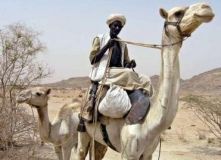Eastern Sudan rebellion only adds to Darfur’s woes
By Pieter Tesch, The Irish Times
KASSALA, eastern Sudan, July 2, 2005 — A rebellion in eastern Sudan threatens to undo the progress made in bringing the rebellions in southern Sudan and Darfur in the west to a peaceful conclusion.

|
|
A Beja man rides his camel in the rebel-controlled area of Eastern Sudan, near the border with Eritrea in this picture taken June 4, 2005. (Reuters). |
Meanwhile, as the African Union-sponsored peace negotiations in the Nigerian capital, Abuja, between the Sudanese government and the two Darfur rebel movements, the Sudan Liberation Movement/Army (SLM/A) and the Justice and Equality Movement (JEM), are stalled again, heavy fighting between rebels and government forces in eastern Sudan is being reported.
The rebels of the so-called “eastern front”, consisting of the armed wing of the Beja Congress, the Rashaida Free Lions and the Darfuri JEM claim to have killed scores of government soldiers in fighting near the town of Tokar, 120km south of Port Sudan on the Red Sea coast last week.
They further allege that the Sudanese government responded with aerial bombardments of civilians in the Barka valley outside Tokar, which was immediately denied by the Sudanese government.
The Canadian government’s special envoy to the Sudan, Senator Mobina Jaffer, warned on returning from his most recent trip to the country that eastern Sudan “could be a Darfur in the making” as more violence was likely in the east.
In recent reports the UN’s World Food Programme (WFP) and Unicef have warned that the level of malnutrition is in fact already worse in eastern Sudan than Darfur because of last year’s drought.
Disease, drought and conflict have reduced by 40 per cent livestock numbers on which the Beja people in eastern Sudan depend for food and wealth in the last five years, according to the International Rescue Committee (IRC).
Any upsurge in fighting or a natural disaster like drought or seasonal floods could produce 200,000 internally displaced people (IDPs) in each of the two eastern states of Red Sea and Kassala, warned the WFP and Unicef.
Goal, which is one of the few aid agencies present in eastern Sudan, is sending 1,000 IDP kits, containing sheets, tents, blankets and cooking utensils, to the holy city of Kassala, on the border with Eritrea.
Its assistant country director for Sudan, Perpetua McShane (37), originally from Draperstown, Co Derry, told The Irish Times that although it was been calm around Kassala, fierce fighting in 1997 and 2002 between rebels and government forces caused thousands of IDPs to flee to the city. Most still lived around Kassala in shantytowns, where Goal has been running healthcare and community development programmes since 1999.
But equally important was the threat of the river Gash flooding. Normally a dry bed, it could burst its banks quickly after heavy rains in the nearby Eritrean and Ethiopian highlands, said Ms McShane. “Floods in 2003 did enormous damage to Kassala, and the forecast is again for heavy rains this season in the highlands,” she said.
The Sudanese government was prepared to respond generously to the grievances of the people in eastern Sudan, but it won’t allow the grievances to be internationalised as had happened in Darfur, the governor of Kassala state, Lieut Gen Hassan Mohammed Nor, told The Irish Times.
He accused the Eritrean government and the Darfuri rebels of JEM of steering the Beja Congress away from a political solution of the grievances in eastern Sudan and instead to an escalation of its armed insurgency.
The Beja, a confederation of native nomadic peoples immortalised by Rudyard Kipling as “Fuzzi-Wuzzies” for their bravery in the Dervish army in 1898 with their shocks of curly hair, complain about marginalisation by the political powers in Khartoum as well as over discrimination of “native” Sudanese people by the “Arab” elite in Sudan, complaints shared with the non-Arabic peoples of southern Sudan and in Darfur.
But in an ironic twist, the Beja Congress formed the “eastern front” in February with the Free Lions movement of the Rashaida, a local Arab tribe, and the JEM from Darfur. The Beja Congress is officially linked with the southern rebel Sudan People’s Liberation Movement/Army (SPLM/A) through the National Democratic Alliance (NDA).
With the help of the Beja Congress and support of the Eritrean government, the SPLM/A occupied in 1997 the Hamish Koreb area, a 40km strip of land along the Eritrean border north of Kassala city.
However, when the SPLM/A signed a peace accord on January 9th with the Sudanese government followed by another accord between the government and the NDA on June 18th, the Beja Congress refused to participate.
Instead JEM fighters are taking over the role of the SPLM/A in eastern Sudan, and renewed fighting here will not only endanger Sudan’s oil exports of 320,000 barrels per day from Port Sudan, but also the relief effort in Darfur.
